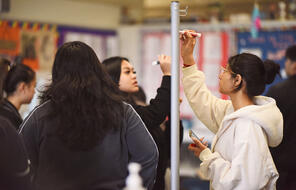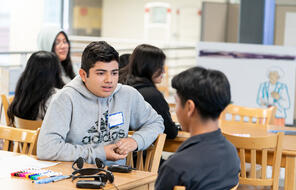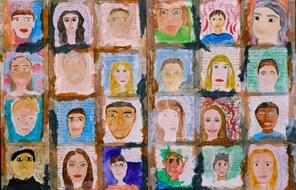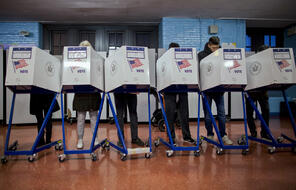Political Polarization in the United States
Subject
- Civics & Citizenship
- History
- Social Studies
Language
English — USUpdated
A. What is political polarization, and is the United States becoming more polarized?
Political polarization is the movement of political views and actions away from the center and toward more extreme views and policies. 1
The United States has two main political parties, the Republican Party and the Democratic Party. In the early 1990s, the two parties had more similar policy agendas than they do today and there was more diversity of opinion within each party. Over the last 30 years, the Democratic Party has moved more to the “left,” while the Republican Party has moved more to the “right.” 2 While political polarization is growing in other countries worldwide, it is more dramatic in the United States. 3
B. What do “left” and “right” mean in American politics?
Politics are complicated, and it is hard to reduce policies to a simple left–right spectrum. The US political parties typically disagree on how much the federal government should regulate the economy, how much power should be given to the federal versus state governments, and how much of a social safety net the government should provide. In general, the left is associated with socially liberal policies and economic policies that create a greater social safety net, while the right is associated with socially conservative policies and less regulation of the economy.
LEFT (liberal)
- Example economic policies: expansion of government-provided health care; increase in minimum wage
- Example social policies: expansion of LGBTQ rights; more pathways to citizenship for immigrants
RIGHT (conservative)
- Example economic policies: lower taxes on wealth; limited government regulation of the economy
- Example social policies: immigration restrictions; limited access to abortion
Thus, the gap between the policy positions of the Democratic and Republican Parties is growing, and more Americans now identify consistently with the main policy positions of their party than in previous years. 4 People often change their political beliefs to match the positions of their party, which reinforces divides between the parties. 5 Furthermore, the overlap between the political values of Democrats and Republicans shrank between 1994 and 2017, as the share of Americans with ideologically consistent values increased. 6
These increasingly deep divides between the political parties in the US are widespread. Sixty-two percent of Republicans and 54% of Democrats had a very unfavorable view of the other party in 2022, which is a higher percentage than it was just five years before. 7
- 1Jeremy Stoddard and Diana E. Hess, “The Effects of Political Polarization on Social Studies Education and What We Should Do,” Social Education 88 (1), January/February 2024.
- 2Pew Research Center, “Political Polarization in the American Public,” Pewresearch.org, June 12, 2014.
- 3Brown University, “U.S. is polarizing faster than other democracies, study finds,” Brown.edu, January 21, 2020.
- 4 Geoffrey Layman, Thomas Carsey, and Juliana Menasce Horowitz, “Party Polarization in American Politics: Characteristics, Causes, and Consequences,” Annual Review of Political Science 9 (2006): 83–110.
- 5Eli J. Finkel et al., “Political sectarianism in America,” Science 370 (6516): 533–36,.
- 6“Political Polarization, 1994–2017,” Pew Research Center, Washington, D.C., October 20, 2017.
- 7Pew Research Center, “Partisan Hostility Grows, Signs of Frustration With Two-Party System,” Pewresearch.org, August 9, 2022.
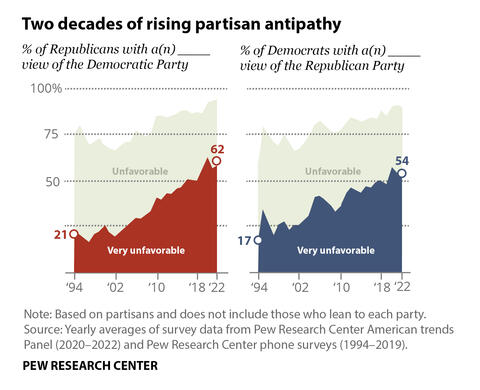
Americans also tend to have greater feelings of dislike toward members of the other political party than they have had in previous years. 1 This is referred to as affective polarization or emotional polarization. 2 Increasing numbers of people now describe those in another political party as close-minded, dishonest, unintelligent, and even immoral. 3
- 1Shanto Iyengar, Guarav Sood, and Yphtach Lelkes, “Affect, not ideology: A social identity perspective on polarization,” Public Opinion Quarterly 76 (3): 405–31.
- 2Brown University, “U.S. is polarizing faster than other democracies, study finds,” Brown.edu, January 21, 2020.
- 3Pew Research Center, “Partisan Hostility Grows, Signs of Frustration With Two-Party System,” Pewresearch.org, August 9, 2022.

Ask Yourself:
What does political polarization look, sound, and feel like where you live?
C. What causes polarization?
Polarization is complex, and scholars are still debating the exact factors that contribute to it. This section highlights four of the many factors that are likely contributing to the rise in polarization.
- Election policies: Recent policy changes have given donors more power to influence which candidates get picked to run for office. For example, campaign finance reforms have made it easier for people to give large amounts of money to the candidate they support. Also, more districts are gerrymandered, 1 which can lead to districts that are overwhelmingly populated by members of the same party. Gerrymandered districts often elect candidates who support policies that appeal more to the party base than those at the center of the political spectrum. Primary elections can push political parties more toward the poles, as well, since candidates often must appeal to activists within their political party in order to win a primary.
- In-group bias: Psychological factors also play a vital role in reinforcing partisanship. While we may like to think that people form their political opinions based on a rational evaluation of different policies, research shows that cognitive biases, such as in-group bias, drive people to change their political opinions to match those of their group.
When we join a group, we are likely to develop positive feelings toward other group members and negative or distrustful feelings toward non-members. 2 In the American two-party system, people often have negative associations with members of the other political party. These negative feelings can make it difficult for people to have productive conversations about policy across political divides. Once people identify as members of a political party, they often switch their political opinions to match the positions of their chosen party. As a result, as political parties become more polarized, so do average voters. 3 - Demonizing difference: When political candidates and the media demonize (or portray as evil) the opposing political party, they increase affective polarization and contribute to the impression that the other group is a threat. 4 The demonization of other groups is one factor that can lead to political violence and support for authoritarianism. For example, 38% of Americans would support “a leader who is willing to break some rules if that’s what it takes to set things right.” 5 Researchers have also found that political polarization rises and falls in relationship to income inequality. 6 So the growing social and economic differences in our country further fuel divisions. The public is also deeply divided about how far the US has progressed in addressing racial inequality and what needs to be done to improve racial equality. There are gaps in how white people and people of color view progress toward racial equality, but the partisan differences are even larger. Seventy-one percent of Republicans say the nation has made a lot of progress toward racial equality over the past half-century, whereas just 29% of Democrats would agree. 7
- Media bubbles: Many Americans are exposed to partisan news in their social media feeds and often have very few social media friends on the other end of the political spectrum. 8 Online platforms such as YouTube use algorithms to expose viewers to increasingly extreme content, which can lead them to encounter fringe political views without their realizing it. 9 The 24-hour partisan news cycle on cable television and on the radio has also deepened political divisions. 10 Spending time in a political echo chamber can make it easier for people to develop negative feelings toward members of the other political party.
D. What are the consequences of polarization?
Political diversity is natural, and polarization is not all bad. The two main political parties in the United States are now more distinct than in previous decades, which gives voters more meaningful choices. 11
However, as political parties move further toward the poles and people increasingly distrust members of the other political party, it has become difficult for politicians to agree on a way forward. Congress is more likely to be limited by partisan gridlock and have difficulty passing legislation, while campaigns and partisan media can become more divisive.
Political polarization has also made it increasingly difficult for people to talk with someone with whom they disagree. Fifty-three percent of Americans say that talking about politics with people they disagree with is “generally stressful and frustrating.” 12
Ask Yourself:
How do you think polarization might influence the way Americans respond to current issues? How do you think polarization might influence how Americans are able to talk with each other about issues that matter?
E. What are the limits of polarization?
Despite growing polarization, Americans are less likely to express negative feelings toward someone of the other political party if they are told that the other person does not care very much about politics, or if they are asked to focus on other aspects of their identities, like their shared identity as Americans or as fans of the same sports team.
In addition, the general public is less divided on a range of issues than in the past. Many policies have bipartisan support, or support from members of both the Republican and Democratic Parties. For example:
78% of Americans are in favor of encouraging highly skilled immigrants to come to the United States. 13
60% of voters support spending $1.3 trillion to weatherize homes, making them more energy efficient. 14
85% of Americans are in favor of requiring background checks on people who buy guns through private sales or gun shows. 15
F. What can I do about the negative effects of political polarization?
Americans across party lines are increasingly concerned about the negative effects of political polarization and the state of our country. 16 Reforming the policies that shape elections, governance, and the media can help to decrease political polarization, but there are also things that individuals can do:
- Focus on issues rather than parties: Decide what policies you want to see passed instead of focusing only on which political party you want to win the election. Try getting involved in local politics, where issues often matter more than political parties.
- Break out of your media bubble: Try to follow a variety of news sources that examine issues from different political angles. You can use AllSides to find out more about the political leanings of different news outlets.
- Learn to listen: Try to understand the perspectives of people on the other side of the political spectrum and listen to other points of view before judging. Read the Greater Good Magazine article Five Ways to Have Better Conversations Across Difference for advice on how to have productive discussions with people who have different perspectives or experiences.
- Find Shared Projects: Seek out projects that can bring about a positive change in your neighborhood or community and that enable you to collaborate with people who are different from you. By helping others and working together to get something positive done, you are Centering the Humanity of Others While Taking Action and shifting away from winning or opposition.
Ask Yourself:
What other individual or policy changes do you think could help to decrease the negative effects of polarization?
- 1Gerrymandering is the practice of drawing the boundaries of a legislative district to give one political party an advantage over the other.
- 2Shanto Iyegar, Yphtach Lelkes, et al., “The Origins and Consequences of Affective Polarization in the United States,” Annual Review of Political Science 22 (2019): 129–46.
- 3Geoffrey Layman, Thomas Carsey, and Juliana Menasce Horowitz, “Party Polarization in American Politics: Characteristics, Causes, and Consequences,” Annual Review of Political Science 9 (2006): 83–110.
- 4Rachel Kleinfeld, “Polarization, Democracy, and Political Violence in the United States: What the Research Says,” Carnegie Endowment for International Peace, September 5, 2023.
- 5PRRI, “Threats to American Democracy Ahead of an Unprecedented Presidential Election,” Prri.org, October 25, 2023.
- 6Nolan McCarty, Keith T. Poole, and Howard Rosenthal, Polarized America (MIT Press, 2016).
- 7Pew Research Center, “Deep Divisions in Americans’ Views of Nation’s Racial History – and How To Address It,” Pewresearch.org, August 12, 2021.
- 8Shanto Iyegar, Yphtach Lelkes, et al., “The Origins and Consequences of Affective Polarization in the United States,” Annual Review of Political Science 22 (2019): 129–46.
- 9Kevin Roose, “The Making of a YouTube Radical,” New York Times, June 8, 2019.
- 10Rachel Kleinfeld, “Polarization, Democracy, and Political Violence in the United States: What the Research Says,” Carnegie Endowment for International Peace, September 5, 2023.
- 11Geoffrey Layman, Thomas Carsey, and Juliana Menasce Horowitz, “Party Polarization in American Politics: Characteristics, Causes, and Consequences,” Annual Review of Political Science 9 (2006): 83–110.
- 12Pew Research Center, “More Now Say It’s ‘Stressful’ to Discuss Politics With People They Disagree With,” Pewresearch.org, November 5, 2018.
- 13Geoffrey Layman, Thomas Carsey, and Juliana Menasce Horowitz, “Party Polarization in American Politics: Characteristics, Causes, and Consequences,” Annual Review of Political Science 9 (2006): 83–110.
- 14Geoffrey Layman, Thomas Carsey, and Juliana Menasce Horowitz, “Party Polarization in American Politics: Characteristics, Causes, and Consequences,” Annual Review of Political Science 9 (2006): 83–110.
- 15Ibid.
- 16PRRI, “Threats to American Democracy Ahead of an Unprecedented Presidential Election,” Prri.org, October 25, 2023.

Political Polarization in the United States
Download a PDF of this resource for free
How to Cite This Explainer
Facing History & Ourselves, “Political Polarization in the United States”, last updated August 26, 2024.

